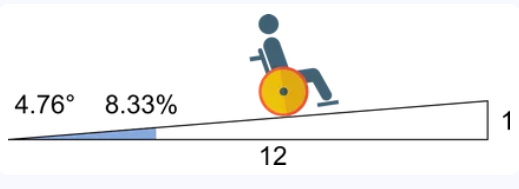1. What is the ADA Max Slope (1:12) Ramp Calculator?

Definition: This calculator determines the slope angle, elevation grade, run, and ramp length for a ramp with a fixed 1:12 slope ratio, as specified by the Americans with Disabilities Act (ADA) for unassisted wheelchair users.
Purpose: It assists architects, builders, and individuals in designing ADA-compliant ramps for wheelchairs, ensuring accessibility and safety in public and commercial spaces.
2. How Does the Calculator Work?
The calculator uses the following equations for a 1:12 slope ratio (1 unit rise per 12 units run):
- Run: \( \text{Run} = \text{Rise} \times 12 \)
- Ramp Length: \( L = \sqrt{\text{Rise}^2 + \text{Run}^2} \)
- Slope Angle: \( \theta = \arctan\left(\frac{\text{Rise}}{\text{Run}}\right) \)
- Elevation Grade: \( G = \frac{\text{Rise}}{\text{Run}} \times 100 \)
Where:
- \( \text{Rise} \): Vertical height to overcome (cm, m, in, ft, or yd);
- \( \text{Run} \): Horizontal length (m or ft);
- \( L \): Ramp length, the hypotenuse (m or ft);
- \( \theta \): Slope angle (degrees);
- \( G \): Elevation grade (percent).
Steps:
- Enter the rise and select its unit (cm, m, in, ft, or yd).
- Convert rise to meters for calculations.
- Calculate the run by multiplying rise by 12 (for 1:12 ratio).
- Calculate the ramp length using the Pythagorean theorem.
- Calculate the slope angle using arctangent.
- Calculate the elevation grade as a percentage.
- Convert run and ramp length to the selected output unit (m or ft).
- Display results, formatted in scientific notation if the absolute value is less than 0.001, otherwise with 4 decimal places.
3. Importance of ADA Max Slope (1:12) Calculation
Calculating the correct ramp dimensions for a 1:12 slope is critical for:
- Accessibility: Ensures safe and comfortable use for unassisted wheelchair users, per ADA standards.
- Safety: Maintains a maximum slope of ~4.8° (8.33%) to prevent accidents.
- Compliance: Meets ADA requirements and building codes for public accessibility.
4. Using the Calculator
Example: Calculate the ramp parameters for an ADA max slope:
- Rise: \( 0.5 \, \text{m} \);
- Slope Ratio: 1:12 (ADA max slope);
- Output Unit: Meters;
- Run: \( 0.5 \times 12 = 6 \, \text{m} \);
- Ramp Length: \( \sqrt{0.5^2 + 6^2} \approx 6.0208 \, \text{m} \);
- Slope Angle: \( \arctan\left(\frac{0.5}{6}\right) \approx 4.7636^\circ \);
- Elevation Grade: \( \frac{0.5}{6} \times 100 \approx 8.3333\% \);
- Result: \( \theta = 4.7636^\circ, G = 8.3333\%, \text{Run} = 6.0000 \, \text{m}, L = 6.0208 \, \text{m} \).
5. Frequently Asked Questions (FAQ)
Q: What does the 1:12 slope ratio mean?
A: A 1:12 ratio means 1 unit of rise per 12 units of run, resulting in a slope of approximately 4.8° or 8.33%, the maximum allowed by ADA for unassisted wheelchair users.
Q: Does the calculator account for ramp landings?
A: No, it calculates the straight ramp segment. For ramps longer than 30 feet (9.14 m) under ADA, landings (minimum 60 in or 1.525 m long) must be added separately.
Q: Why is the 1:12 ratio important?
A: The 1:12 ratio is the steepest slope allowed by ADA for unassisted wheelchair users, balancing accessibility with space constraints in public and commercial settings.
ADA Max Slope (1:12) Ramp Calculator© - All Rights Reserved 2025
 Home
Home
 Back
Back

